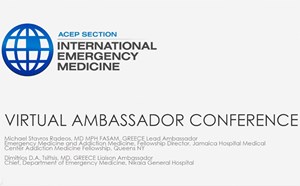Emergency Medicine in Crisis: The Challenges of UK Corridor Care and Exit Block
Watch this International EM Section Virtual Ambassador Conference webinar covering emergency medicine in the UK. Dr. Syed Naqvi and Dr. Immad Qureshi present.
Read the Full Transcript
- Hi guys, my name is Syed, and I will be joined by my colleague, Dr. Immad Qureshi in giving this presentation about challenges of corridor care and exit blocks. Next slide, please. So over the next five minutes, we'll be just giving you a whistle stop tour of the following. Next slide, please. So, we'll start by defining the unacceptable reality of emergency care. So, exit blocks are situations where patients who've been assessed in the emergency department, are unable to leave the department due to lack of capacity in the downstream system. So, the most commonly identified cause is the lack of bed capacity in admitting hospitals. Whereas corridor care is the practice of treating patients in a nonclinical area of the hospital, such as corridors, waiting rooms, or store rooms due to the lack of availability of beds and cubicles in the emergency department. Also, ambulances queuing up outside the EDs are unable to offload patients, which results in delays of handover and harm to the patients while in the back of the ambulance. The Royal College of Emergency Medicine or RCEM, strongly opposes these practices, as they are unsafe, undignified, and demoralizing for both the staff and the patients. Next slide, please. It's Dr. Immad here.
- Hello, good afternoon, everyone from the UK. I apologize for any noise in the background, I'm in an overcrowded emergency department right now, covering the second day of junior doctor strike, so trainee doctor strike in the UK. And sat in my office, which is right next to the ambulance entrance, so any blue lights you might hear. So, the problem is, I guess quite common and quite similar to problems elsewhere in the world. We, in the last year, have had 400,000 people who've waited in an emergency department for over 24 hours, just waiting to get onto a hospital bed. And these figures are sometimes manipulated a little bit, and may not include those patients who got better within those 24 hours or 26 hours they waited, and ended up being discharged, so they never ever made it to a hospital ward or a bed in the hospital. In addition to this, because we're trying to catch up with all the exit block, electives are being delayed and canceled as well. And so, we've got about 12,000 deaths in the last year that are attributable to people waiting for care, whether in the emergency department or for elective care. We've also had over 9,000 patients wait over 10 hours in the back of an ambulance. I mean, if were to give anecdotal examples, I recall a patient who, one of my colleagues saw in the back of an ambulance after they were there for eight hours. So, being cared for by the ambulance staff, and went in, the elderly patient who'd come in with abdominal pain, decided to just take an ultrasound machine with him, took his Butterfly iQ+ with him, looked at the abdominal aorta, and found that the patient had a 10 centimeter abdominal aortic aneurysm. Got him into a CT straight from the ambulance, never went into ED, and was triaged, went straight to radiology, and ended up in theaters having bypassed the ED completely, but only because they spent 10 hours in the back of an ambulance. So, those are the real kind of pressures that we're dealing with in the emergency departments. If you could have the next slide, please. I mean, there's no new information here, the causes of the problems we're seeing are exit blocks, it's the lack of capacity, it is an increasing patient demand for ED services, some of which is artificial because we have ended up becoming the safety net for the whole healthcare in the UK. A patient cannot access their primary care services, they end up in the emergency department, they've had a procedure or surgery, and they have a complication. They end up in the emergency department. We somehow have ended up now even being the safety net for people not being able to see a dentist because they have a dental abscess where emergency physicians have almost no training in managing dental problems. The consequences of all this are, understandably, there's increased mortality, there's increased morbidity, it's makes for a very poor patient experience, we've seen 300% increase in the number of complaints we're dealing with, their longer length of stays in hospital, and obviously, with recent Covid and current respiratory illnesses, it leads to a lot of transmission of infections from non-infected patients, so infected patients to non-infected patients. Could I have the next slide, please? So, the Royal culture of Emergency Medicine absolutely says we should not have any care for patients in corridors. And it is a big stay of the Resuscitate ED Manifesto that they have put out for the election. I've got the same QR code twice on the slide where you can actually point to the slides, and open the whole manifesto on your phones. But the four key points for us are, we need to end overcrowding in emergency departments, and we need to end having queues, ambulance queues outside our hospitals. We definitely need to ensure that the government, whichever government comes into power next and the elections, is able to provide the UK with enough emergency staff, that's doctors, nurses, and all other healthcare professionals to be able to deliver safe and sustainable care to our patients. We want the whole of the NHS to be able to provide equitable care that we need the resources for that, we need beds for that. We need more capacity. We need to do away with this airline mentality of being overbooked. We need to operate at a less than 100% bed occupancy. And our recommendation from RCEM is 85%, and we need to introduce transparent ways of measuring to our performance. The big line in the UK has always been for our performance, so we want 95% of our patients to be seen and managed, and discharged, whether they're discharged to a bed in the hospital, or discharged home within four hours, that has not been met for the last six years. And so, the government scraped that and decided to put in alternative standards to be met. None of the standards come up to the mark. So if we could go to the next slide, please. So in conclusion, this is a huge crisis, which has got multiple layers to it, but overcrowding, understaffing, and underfunding are the key elements. I will let Syed continue with the rest of the presentation, thank you for listening to me.
- Hi. So, just taking over now, as Dr. Immad mentioned, the UK is currently grappling with a multifaceted crisis characterized by overcrowding, severe understaffing, and chronic underfunding. RCEM has taken a proactive stance by releasing two pivotal documents called "The Acute Insight Series on Crowding and Its Consequences." And then, the second document's called "Resuscitate Emergency Care Manifesto," which was linked in the previous slide. These documents serve as beacons, illuminating the challenges faced by emergency departments, and advocating for urgent remedial measures. The documents outline the causes and effects of ED crowding, and propose a series of recommendations for the government, the NHS, and other stakeholders to implement. These include increasing bed capacity, enhancing alternative pathways, improving hospital flow, resourcing the emergency care system, amongst other action necessary. We can end the unacceptable and unsafe practices of corridor care, and long wait, and ensure that every patient who needs emergency care receives it in a timely, safe, and appropriate manner. The path forward lies in collective commitment, innovative solutions, and unwavering advocacy for a resilient emergency care system. Next slide, please. Here's our references for the documents we mentioned. And next slide, please. And thank you for listening.
- Yeah, I'd just like to take a minute here to tell everybody that despite all these challenges, as emergency physicians, we are the most resilient and the most flexible group of practitioners in the healthcare system. So, we have found ways to make things less unsafe, I wouldn't say we've made things any safer, but they're less unsafe. So, we've got ways that we're dealing with, patients in corridors. We're reverse boarding patients, so when the ambulances come in, patients who've already been seen sorted and dusted, get moved out of cubicles into the corridor, so that we can see the patients that have come in. We're putting doctors in the back of ambulances when the ambulances arrive, so because they become our responsibility once they land on the hospital's premises, even if it's joint care, we start cohorting patients, so ambulance staff, ambulance services will provide a HALO, a hospital ambulance liaison officer who will look after four or five ambulance patients in a area within the hospital, but they're not being looked after by ED yet, even though we still have joint care. And then, we're opening up added areas, we're one-upping and two upping on the wards to get patients out in a continuous flow model. So, lots of things being done despite the fact that the college does not want this to be the norm, but it is happening currently, and we've got to make it as less unsafe for our patients as possible. So, thank you for listening to us.



